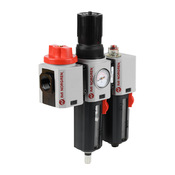 Cookies are not enabled on your browser.
Cookies are not enabled on your browser.Cookies are required for our site. Please enable cookies in your browser preferences to continue.
- Barcode / RFID / Vision
- Bulk Wire & Cable
- Cables (Terminated)
- Circuit Protection / Fuses / Disconnects
- Communications
- Drives & Soft Starters
- Enclosure Thermal Management & Lights
- Enclosures & Racks
- Field I/O
- HMI (Human Machine Interface)
- Hydraulic Components
- Motion Control
- Motor Controls
- Motors
- Pneumatic Components
- Power Products (Electrical)
- Power Transmission (Mechanical)
- Process Control & Measurement
- Programmable Controllers
- Pushbuttons / Switches / Indicators
- Relays / Timers
- Safety
- Sensors / Encoders
- Stacklights
- Structural Frames / Rails
- Tools & Test Equipment
- Valves
- Water (Potable) Components
- Wire & Cable Management
- Wire & Cable Termination
- Retired Products
Configuration Utilities
- PLC Family Selector
- P1000 PLC Systems
- P2000 PLC Systems
- P3000 PLC Systems
- ProductivityCODESYS
- CLICK PLC Systems
- Do-more® BRX PLC Systems
- LS-Electric® XGB PLC Systems
- Productivity®Open Systems
- Datalogic® Safety Light Curtains
- LS-Electric® Servo Systems
- Nitra® Pneumatic Grippers
- Object Detection (Sensors)
- PAL Controller Configurator
- Precision Gearbox Selector
- Protos X® Field I/O
- Pyrometers Selector
- Quadritalia® Modular Enclosures
- Stellar® Soft Starters
- Stepper System Selector
- SureFrame T-slot Extrusion
- SureMotion® XYZ Gantry
- SureServo2® System Selector
- SureStep® Linear Actuators
- Timing Belts & Pulleys
- Werma® Stacklights
- ZIPLinks
Filters, Regulators, and Lubricators
Air Prep Basics:
A steady supply of clean and dry air is required to power and protect pneumatic components in machines, equipment and processes and to ensure their proper operation. All pneumatic motion, including clamping, positioning, pushing, lifting, etc. requires clean and dry air with enough flow to provide the required pressure. The process of filtering, regulating (and sometimes lubricating) this compressed air is known as "Air Prep".
It starts at the shop or plant level
Facilities often have a main "plant" or "shop" compressor, which feeds a network of pipes, fittings, and devices. These components may introduce particulates, moisture or other contaminants. Even if the shop has dryers, filters, moisture separators and regulators at (or near) the compressor, it is also wise to provide some air prep at the machine level also. At a minimum, air prep at-the-machine should include filtering, regulating, and some form of shut-off or "air dumping" for safety and routine maintenance.


Signs you may have an Air Prep problem:
- Valves sticking
- Valves leaking when off
- Seal wear and damage
- Premature wear of cylinders and and other actuators
- Cylinders filling with water over time
- Locked cylinders
- Oil and contaminates clogging-up valves, especially small pilot ports and mufflers.
Reasons to provide Air Prep at each machine:
- Regulate pressure to a known value for proper machine operation
- Filter contaminants due to plant plumbing
- Filter to a finer level than the overall shop filters
- Provide shutoff (manual or electric) for safety and maintenance
Provide Adequate Air Flow
In larger facilities the air supply may be taken for granted. Without adequate air flow the pressure will sag during use, especially during high demand periods. Oversizing the shop plumbing is almost always a good idea, but also make sure the compressor is sized for the current demand, or better yet: invest in a larger, more efficient systems when possible to plan for future growth.
And oversizing the air preparation system is another smart move, providing excess capacity for additions or unanticipated demands. The air prep system should start with a manual shutoff relief valve with lock-out to remove air for maintenance. For additional safety, OSHA also requires air to be dumped during an emergency stop or other safety event. Consider an electrical soft start valve that dumps air when power is removed. A soft start valve also keeps the pneumatic equipment from banging when air is applied.
Shop for Standard Air Preparation Components:
Check out our job openings
Free Online PLC Training
FREE Video Tutorials
FREE e-Newsletter
Automation Notebook
Product Literature
White Papers
News, Product and Training Bulletins
E-Books
 Safe &
Secure
Safe &
Secure

We accept VISA, MasterCard, Discover, American Express, PayPal or company purchase orders.
Voted #1 mid-sized employer in Atlanta
Check out our
job openings

